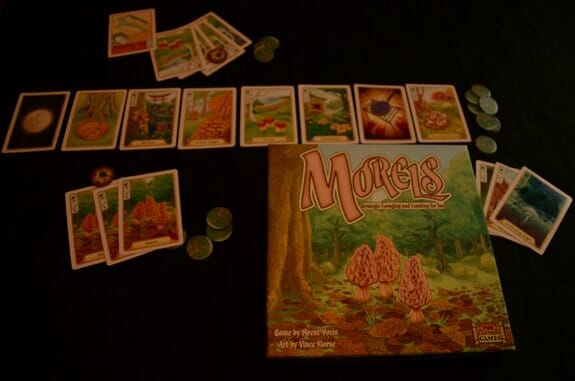Boardgame: Morels

Morels is a new two-player card game where players take on the role of mushroom foragers, working to collect sets of cards depicting various mushroom types and either selling those cards for currency or cooking them for points. While some mushroom types are plentiful, others are scarce, and the opportunities to pick them are limited, creating competition with your opponent to collect the most valuable varieties while also forcing you to think two or three moves ahead to maximize the value of your turns.
The entire game comprises 96 cards and a handful of cardboard tokens representing sticks (the game’s currency) plus one frying pan for each player. The cards are then split into two decks, 88 cards in the day deck and eight in the special night deck, the latter of which is laid face-down adjacent to the main playing area. Each player receives a starting hand of four cards from the shuffled day deck, after which the “forest,” eight cards in a row, is laid out on the table to start the game. The two cards at the right of the forest are available for foraging for no cost; each card to the left of those two is available if the player spends from one to six sticks to forage them, with the number of sticks corresponding to the card’s distance from the two free cards. After each player’s turn, the forest shifts, with the rightmost card falling into the “decay” area, and every remaining card shifting to the right to fill in the empty spots. Therefore, the card you want or need may not be available for long, even if your opponent doesn’t claim it first.
The day deck contains cards of nine mushroom types for players to collect, from the cheap and unappetizing honey fungus (Armillaria mellea, a hardy, extremely long-lived mushroom, considered a delicacy in eastern Europe) to the true morel (genus Morchella, a wild mushroom often found after forest fires). The cheaper the mushroom, the more of its cards in the deck, and the lower its value when sold or cooked. The day deck also includes Basket cards, each of which allows the player to extend his hand limit by two cards; Pan cards, with one required for each batch of mushrooms a player wishes to cook; Butter and Cider cards, allowing for bonus points if cooked with sets of four or five mushroom cards; and Moon cards, one of which allows the player to draw a card from the Night deck. That deck contains one card of each mushroom type except Morels, and a Night card counts as two mushrooms for scoring or for meeting the minimums to sell (two cards) or cook (three) a batch of mushrooms.
Morels offers a balance between short- and long-term decision-making, mostly revolving around the constraint of the limit of cards a player may hold in his/her hand. That normal limit is just eight cards, before Baskets, and a player will frequently have to choose whether to cook a set of mushrooms now, locking in points and clearing space in his hand, or holding out to try to add additional cards to the set to raise its point value. Once a set of mushrooms is cooked, the player may not add any cards to that set, or remove any, so some cards still in the forest or in the deck will become useless because they won’t have enough similar cards still in play to form a complete set. Choosing cards from the forest invokes the same conflict between short- and long-term considerations, as well as the mechanic that means that taking a specific card likely makes the adjacent card unavailable to the same player on his/her next turn.


